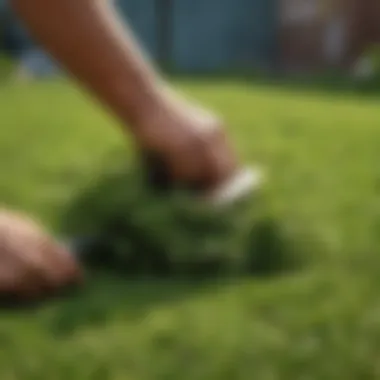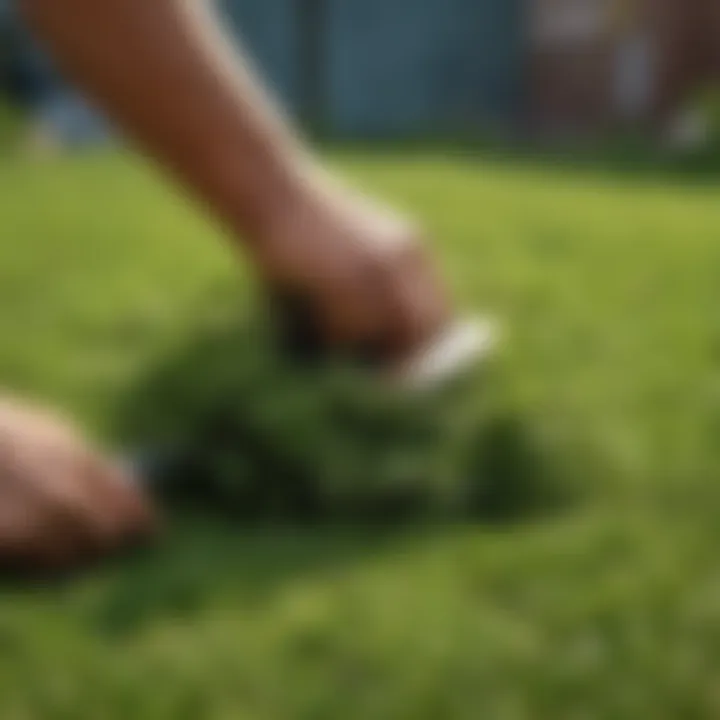Mastering Weed Control: The Ultimate Lawn Care Guide


Overview of Topic
In the realm of home improvement, one of the paramount areas of concern for housewives and homeowners alike is the meticulous care and maintenance of their lawns. An aesthetically pleasing and vibrant lawn not only enhances the curb appeal of a property but also serves as a personal sanctuary for relaxation and recreation. Weed control plays a pivotal role in achieving and maintaining a lush and healthy lawn, establishing the groundwork for a verdant outdoor oasis that can be enjoyed year-round.
The importance of effective lawn weed control cannot be understated. Weeds not only detract from the visual appeal of a lawn but also compete with grass and plants for nutrients, sunlight, and moisture. Failure to address weed infestations promptly can result in the spread of these undesirable intruders, leading to the gradual deterioration of the lawn's overall health and vibrancy.
Common Challenges and Solutions
Homeowners frequently encounter a myriad of challenges when it comes to combating weeds in their lawns. Common issues range from persistent dandelions and crabgrass to invasive broadleaf weeds that threaten to overrun the turf. To overcome these challenges, a proactive approach combining preventive measures and targeted treatments is imperative.
Implementing a routine maintenance schedule that includes practices such as mowing at the correct height, regular watering, and proper fertilization can help bolster the lawn's strength and resilience against weed encroachment. Additionally, integrating cultural control methods like overseeding thin areas and practicing good soil health can create a robust turf that naturally suppresses weed growth.
For more tenacious weed problems, employing herbicidal solutions tailored to specific weed types and application timing can provide effective control. Selective herbicides target broadleaf weeds while sparing desirable grass species, offering a targeted approach to weed management.
Product Recommendations
When it comes to selecting the best products for lawn weed control, industry-leading brands like Scotts, Ortho, and Roundup offer a diverse range of herbicides catered to different weed varieties and application preferences. Scotts Turf Builder Weed and Feed, renowned for its dual-action formula that kills weeds while feeding the grass, stands out as a popular choice among homeowners seeking comprehensive weed control and lawn nourishment.
Ortho Weed B Gon Weed Killer for Lawns is another top contender, known for its quick and effective elimination of common lawn weeds like clover and chickweed. The product's convenient hose-end sprayer simplifies application, making it a practical solution for tackling lawn weed issues efficiently.
For a more targeted approach, Roundup Extended Control Weed and Grass Killer offers long-lasting protection against persistent weeds like crabgrass and dandelions. Its extended control formula creates a barrier that prevents weed regrowth for up to four months, ensuring lasting weed suppression and a pristine lawn appearance.
Step-by-Step Guides
To initiate the journey towards an impeccably maintained lawn free of weeds, a systematic approach combining proper lawn care practices and effective weed control strategies is paramount. Begin by assessing the current condition of the lawn and identifying prevalent weed species to tailor treatment plans accordingly.
- Assessment and Planning: Conduct a thorough inspection of the lawn to determine weed types, distribution, and density. Develop a comprehensive weed control plan that integrates both preventive measures and targeted treatments.
- Preventive Measures: Implement cultural practices like proper watering, fertilization, and mowing height to promote a healthy turf that naturally resists weed encroachment. Address soil deficiencies and compacted areas to create an optimal growing environment for grass.
- Herbicide Application: Select appropriate herbicides based on the weed species present in the lawn. Follow label instructions carefully for optimum efficacy and safety. Applying herbicides during recommended times and weather conditions enhances their effectiveness in targeting weeds while minimizing impact on non-target plants.
- Post-Treatment Care: Monitor the lawn post-treatment to assess the success of weed control efforts. Implement follow-up treatments as necessary to address any remaining weed populations and prevent reinfestation. Regular maintenance practices should be continued to uphold a weed-free lawn.
By following these step-by-step guides and incorporating recommended products into your lawn care regimen, you can establish a comprehensive strategy for achieving and maintaining a weed-free, vibrant lawn that serves as a source of pride and enjoyment for years to come.
Understanding Weed Control
In the realm of lawn care, understanding weed control is paramount to achieving a pristine outdoor space. Weeds not only detract from the visual appeal of a lawn but also compete with desirable plants for essential resources like water, nutrients, and sunlight. This comprehensive guide on lawn weed control delves deep into the various types of weeds that can infiltrate your turf, the impacts they can have on your lawn's health, and the benefits reaped from effective weed control measures.
Types of Lawn Weeds
Grassy Weeds
Grassy weeds are a common nuisance in lawns, characterized by their thin, elongated blades that can quickly overtake a well-tended turf. Their ability to spread rapidly and blend with existing grass makes them a challenge to eradicate completely. While some grassy weeds may offer a lush appearance, the competitive nature of these plants can choke out desired grass species, leading to an uneven and unsightly lawn if left unchecked.
Broadleaf Weeds
Broadleaf weeds, on the other hand, exhibit distinct leaves that are broader than grassy weed species. These weeds often stand out against the uniform texture of grass, disrupting the overall aesthetic of the lawn. Their tendency to grow rapidly and produce flowers can result in a weedy appearance that diminishes the curb appeal of your outdoor space.
Sedge and Rush Weeds
Sedge and rush weeds present unique challenges due to their adaptability to wetter environments. These moisture-loving plants can thrive in areas where traditional grasses struggle, such as in poorly drained soil or near water features. While they may add diversity to a lawn, sedge and rush weeds can quickly take over if not managed effectively, leading to a patchy and unkempt look.
Impact of Weeds on Lawn Health


Competition for Resources
Weeds pose a significant threat to the health of lawns by competing for essential resources such as water, sunlight, and nutrients. Their aggressive growth patterns can outpace desirable plants, resulting in stunted growth and weak turf. By monopolizing these vital resources, weeds inhibit the healthy development of grass, leading to a lackluster lawn that struggles to thrive.
Aesthetic Degradation
The presence of weeds in a lawn can cause aesthetic degradation, detracting from the visual appeal of the outdoor space. Unsightly patches of weeds can interrupt the uniformity of the grass, creating a patchwork effect that diminishes the overall attractiveness of the turf. Additionally, the proliferation of weeds can signal neglect and impact the perceived value of the property.
Spread of Diseases
Weeds not only encroach upon the territory of desirable plants but can also serve as hosts for various diseases and pests. Their presence can facilitate the transmission of pathogens to healthy plants, leading to widespread infestations and decreased vitality in the lawn. Controlling weeds is crucial in preventing the spread of diseases that could wreak havoc on the ecosystem of your outdoor oasis.
Benefits of Weed Control
Promotes Healthy Turf Growth
Implementing effective weed control measures promotes healthy turf growth by removing competition for vital resources. With weeds out of the picture, grass can thrive without impediments, leading to a lush and vigorous lawn that enhances the beauty of your landscape. By fostering optimal growing conditions, weed control sets the stage for a robust and resilient turf.
Enhances Curb Appeal
Weed control plays a pivotal role in enhancing the curb appeal of your property, ensuring a well-manicured and inviting outdoor space. A weed-free lawn exudes cleanliness and attentiveness, elevating the overall aesthetics of your home's exterior. By showcasing a pristine turf free of unsightly weeds, you create a welcoming environment that leaves a lasting impression on visitors and passersby.
Prevents Weed Infestations
One of the primary advantages of consistent weed control is the prevention of weed infestations. By employing proactive measures to combat weeds, you nip potential invasions in the bud before they spiral out of control. Preventing weed infestations not only saves time and effort in the long run but also safeguards the health and vitality of your lawn, preserving its immaculate condition.
Preventive Measures
In the quest for a lush and weed-free lawn, preventive measures play a crucial role in maintaining the overall health and aesthetics of your outdoor space. By implementing proactive strategies, you can ward off weeds before they become a nuisance, thereby reducing the need for intensive intervention later on. One of the key benefits of preventive measures is the promotion of long-term turf health and vitality, as a well-maintained lawn is better equipped to resist weed infestations. Furthermore, these measures enhance the curb appeal of your property, creating a visually pleasing and inviting outdoor environment. Considerations such as proper timing for application, environmental impact, and effectiveness on different weed types are essential aspects to ponder when devising a weed control plan. Integrating preventive measures into your lawn care routine not only saves you time and effort in the long run but also contributes to sustainable and eco-friendly gardening practices.
Proper Lawn Maintenance Practices
Regular Mowing and Watering
Regular mowing and watering are cornerstones of effective lawn care, contributing significantly to the overall health and appearance of your turf. Consistent mowing at the appropriate height helps to stimulate grass growth, maintain an even canopy, and prevent weed seeds from germinating. Proper watering, emphasizing deep but infrequent irrigation, encourages robust root development and drought tolerance, leading to a more resilient lawn. The key characteristic of regular mowing and watering lies in their ability to create an optimal growing environment for desirable grass species while inhibiting weed proliferation. While these practices are fundamental and widely recognized in lawn maintenance, their simplicity belies their crucial role in weed prevention and overall turf management.
Overseeding
Overseeding involves planting grass seed into existing turf to replenish thin or damaged areas, enhance lawn density, and outcompete weeds. This practice not only fills in bare patches but also introduces newer grass varieties that exhibit improved resistance to pests, diseases, and harsh environmental conditions. By boosting the overall health and thickness of your lawn, overseeding acts as a preemptive measure against weed encroachment, creating a dense turf that shades out potential weed seedlings. While overseeding requires an initial time investment and careful attention to watering and maintenance, the long-term benefits of a thicker, more resilient lawn outweigh the temporary inconveniences.
Aeration
Aeration is a critical yet often overlooked practice that involves perforating the soil with small holes to alleviate compaction, improve air circulation, and stimulate root growth. By allowing nutrients, water, and oxygen to penetrate deep into the soil, aeration fosters a robust root system that is essential for a healthy lawn. The key feature of aeration lies in its ability to address soil compaction, which restricts root development and inhibits the absorption of essential nutrients. While manual or machine aeration methods may vary in intensity and invasiveness, the overall advantage of promoting soil aeration for weed control is undeniable. Though it may seem like a labor-intensive task, the benefits of improved soil structure and nutrient uptake far outweigh the initial efforts required for aeration.
Control Strategies
Control strategies are crucial in the realm of effective lawn weed control, playing a pivotal role in ensuring the health and aesthetic appeal of your lawn. In this article, we delve into specific elements, benefits, and considerations surrounding control strategies, providing you with a comprehensive understanding of how to combat weeds and promote a flourishing lawn ecosystem.
Chemical Weed Control
Chemical weed control is a fundamental aspect of managing weeds in your lawn. Within this domain, we encounter three main categories: selective herbicides, non-selective herbicides, and integrated pest management.


Selective Herbicides
Selective herbicides are a specialized category of weed killers that target specific types of weeds while sparing desired vegetation. Their key characteristic lies in their targeted approach, which allows for precise weed eradication without harming grass and plants. Selective herbicides are a popular choice due to their effectiveness in eliminating weeds while preserving the health of your lawn. However, it is essential to note their unique feature of requiring careful application to avoid unintended damage to non-target plants.
Non-Selective Herbicides
Non-selective herbicides, in contrast, do not discriminate between weed species and other vegetation. They provide a broad-spectrum solution for weed control, effectively eradicating all plant growth in the treated area. The key characteristic of non-selective herbicides is their comprehensive approach to weed elimination. While they offer a quick and efficient method for clearing large weed-infested areas, their downside lies in the potential for unintended damage to desirable plants through accidental overspray or runoff.
Integrated Pest Management
Integrated pest management involves a holistic approach to weed control that combines chemical, biological, and cultural methods. This comprehensive strategy aims to manage weeds through a balanced ecosystem without relying solely on chemical intervention. The key characteristic of integrated pest management is its sustainable and environmentally friendly nature, reducing the reliance on synthetic chemicals. Despite its advantages, this approach may require more time and effort to implement effectively.
Organic Weed Control Methods
Organic weed control methods offer natural alternatives to chemical herbicides, catering to those seeking environmentally friendly lawn care solutions. Within this domain, we explore homemade remedies, biological control agents, and corn gluten meal.
Homemade Remedies
Homemade remedies utilize common household ingredients to create natural weed control solutions. Their key characteristic lies in their eco-friendly and cost-effective nature, making them a popular choice for environmentally conscious individuals. However, the effectiveness of homemade remedies may vary, and they may require repeated applications for optimal results.
Biological Control Agents
Biological control agents involve the use of living organisms to combat weed growth, such as insects or beneficial fungi. Their key characteristic is their natural and sustainable approach to weed suppression, harnessing the power of biological agents to manage weed populations. While biological control agents offer long-term benefits for your lawn ecosystem, their efficacy may be influenced by environmental factors and specific weed species.
Corn Gluten Meal
Corn gluten meal is a natural pre-emergent herbicide derived from corn processing. Its key characteristic is its dual function as a weed suppressant and organic fertilizer, enriching the soil while inhibiting weed seed germination. A popular choice for organic lawn care enthusiasts, corn gluten meal provides a natural and non-toxic alternative to traditional herbicides. However, its application may require careful timing and consistent use to achieve desired weed control results.
Manual Weed Removal Techniques
Manual weed removal techniques offer a hands-on approach to tackling weeds without the use of chemicals or herbicides. In this section, we explore hand pulling, weed digging tools, and sod cutters.
Hand Pulling
Hand pulling involves physically uprooting weeds from the soil by hand. Its key characteristic is its simplicity and precision, allowing for targeted weed removal without disrupting surrounding plants. While hand pulling is a straightforward and inexpensive method, it may be labor-intensive for large weed infestations, requiring regular maintenance and attention.
Weed Digging Tools
Weed digging tools encompass a range of specialized instruments designed to extract weeds from the root. Their key characteristic lies in their efficiency and effectiveness in removing deep-rooted weeds from the soil. Weed digging tools offer a practical solution for tackling stubborn weeds in your lawn, providing a tool for targeted and thorough weed eradication. However, improper use of these tools may result in soil compaction or damage to nearby plants.
Sod Cutters
Sod cutters are mechanical devices used to remove patches of grass and weeds from the lawn. Their key characteristic is their ability to create clean and precise cuts, facilitating the removal of large areas of unwanted vegetation. Sod cutters are a time-saving option for clearing large sections of lawn infested with weeds. However, their operation may require skill and caution to avoid damaging surrounding grass and plants.
Best Weed Control Products
The pivotal aspect of weed control lies in selecting the best weed control products for your lawn. Choosing the right products can determine the success of your lawn maintenance efforts and ensure a lush, weed-free landscape. From herbicides to natural options, the market offers a range of solutions to combat weeds effectively. Understanding the specific elements, benefits, and considerations of best weed control products is essential in achieving your goal of a vibrant and healthy lawn.
Top-Rated Herbicides
Scotts Turf Builder Weed and Feed


Scotts Turf Builder Weed and Feed stands out as a top-rated herbicide renowned for its dual action of feeding your lawn while eliminating weeds. Its unique formula not only targets existing weeds but also nourishes your turf to promote healthier growth. The key characteristic of Scotts Turf Builder Weed and Feed is its ability to efficiently tackle various weed types, including common broadleaf weeds, without harming the grass. This makes it a popular choice for homeowners looking to combat weeds effectively while enhancing the overall health of their lawn. Despite its effectiveness, some users might find the chemical composition of the product as a potential disadvantage, especially if seeking completely organic solutions.
Ortho Weed B Gon
Ortho Weed B Gon is a widely recognized herbicide known for its targeted approach to weed control. Its key characteristic lies in its precision application, allowing users to spot-treat specific areas afflicted by weeds without affecting the surrounding grass. This targeted approach makes Ortho Weed B Gon a beneficial choice for addressing weed infestations without harming the rest of your lawn. The unique feature of Ortho Weed B Gon is its fast-acting formula, providing visible results within hours of application. However, one potential disadvantage could be its chemical composition, which may not align with organic gardening preferences.
Roundup Extended Control Weed and Grass Killer
Roundup Extended Control Weed and Grass Killer is a potent herbicide designed to combat tough weeds and grasses efficiently. Its key characteristic includes an extended control feature that prevents weed regrowth for up to four months, offering long-term weed management benefits. The unique feature of Roundup Extended Control is its dual-action formula that kills weeds down to the root while creating a protective barrier to prevent future growth. This makes it a popular choice for homeowners seeking a lasting solution to persistent weed problems. However, as with many chemical herbicides, one common concern is the potential environmental impact and health risks associated with its use.
Natural Weed Control Options
When looking for natural alternatives to chemical herbicides, several options stand out for their effectiveness in weed control.
Espoma Organic Weed Preventer
Espoma Organic Weed Preventer is a natural herbicide that inhibits weed growth without the use of synthetic chemicals. Its key characteristic is its organic composition, making it a safe and eco-friendly option for controlling weeds in your lawn. The unique feature of Espoma Organic Weed Preventer is its slow-release formula, providing long-lasting weed suppression while nourishing the soil with essential nutrients. This makes it a beneficial choice for homeowners looking to maintain a chemical-free lawn. However, the gradual nature of its weed control action may require patience compared to fast-acting chemical alternatives.
Green Gobbler Vinegar Weed & Grass Killer
Green Gobbler Vinegar Weed & Grass Killer offers a natural and rapid solution to weed control with its acetic acid-based formula. Its key characteristic lies in the powerful desiccating effect of vinegar on weeds, effectively drying out and killing unwanted plants. The unique feature of Green Gobbler Vinegar Weed & Grass Killer is its fast action, delivering visible results within hours of application. This makes it a popular choice for immediate weed removal needs without the use of synthetic chemicals. However, its non-selective nature may require careful application to avoid damaging desired plants in the vicinity.
Preen Vegetable Garden Organic Weed Preventer
Preen Vegetable Garden Organic Weed Preventer is specifically formulated for organic gardening practices, offering a natural solution to weed prevention in vegetable gardens. Its key characteristic includes a selective herbicidal action that targets weeds while being safe for use around edible plants. The unique feature of Preen Vegetable Garden Organic Weed Preventer is its long-lasting weed control, providing up to three months of protection from weed growth. This makes it an ideal choice for gardeners looking to maintain a healthy and thriving vegetable garden without the interference of weeds. However, users should be cautious when applying around desired plants to prevent accidental damage.
Maintaining Weed-Free Lawns
Maintaining a weed-free lawn is crucial for ensuring the health and vitality of your outdoor space. In this section, we will explore the specific elements, benefits, and considerations associated with keeping your lawn free from weeds. A weed-free lawn not only enhances the overall aesthetics of your property but also promotes healthy turf growth by preventing weed infestations. By following the strategies and tips outlined in this article, you can enjoy a lush and impeccable lawn that becomes the envy of your neighborhood.
Seasonal Weed Control Tips
Spring Weed Control
Spring weed control plays a pivotal role in setting the tone for a weed-free lawn throughout the year. Its key characteristic lies in targeting early weed growth, effectively curbing the spread of weeds in the crucial growing season. The unique feature of spring weed control is its ability to tackle weeds before they establish deep roots, thus reducing the need for extensive weed removal later on. While spring weed control requires timely intervention and application of herbicides, its advantages include maintaining a healthy turf without the threat of weed overgrowth.
Summer Weed Control
Summer weed control focuses on managing existing weeds and preventing new ones from taking root. Its key characteristic involves targeting weeds at their peak growth stage when they are most susceptible to treatment. The unique feature of summer weed control is its emphasis on selectively targeting specific weed species while preserving the health of desired turf grass. Though summer weed control demands consistent monitoring and application, its benefits include a well-maintained lawn without compromising the overall soil health.
Fall Weed Control
Fall weed control is essential for preparing your lawn for the upcoming dormant season, ensuring a weed-free start in the following year. Its key characteristic lies in addressing lingering weeds and preventing their reemergence in the spring. The unique feature of fall weed control is its focus on building resistance against winter weeds, thereby minimizing weed invasion in the colder months. While fall weed control requires foresight and timing, its advantages encompass a weed-resistant turf that thrives and regenerates effectively.
Integrated Lawn Care Practices
Proper Fertilization
Proper fertilization is a cornerstone of maintaining a weed-free lawn, as it provides essential nutrients for turf growth while inhibiting weed proliferation. Its key characteristic involves using balanced fertilizers suitable for your specific grass type, enriching the soil for healthy lawn development. The unique feature of proper fertilization is its ability to boost turf resilience against weed encroachment by promoting dense grass growth. While proper fertilization demands precision and periodic application, its benefits include a lush, green lawn with minimized weed presence.
Correct Irrigation Techniques
Correct irrigation techniques play a vital role in supporting a weed-free lawn by optimizing water distribution and minimizing weed-friendly conditions. Its key characteristic lies in delivering water efficiently to the roots without creating waterlogged or drought-prone areas. The unique feature of correct irrigation techniques is their capacity to prevent weed establishment by creating unfavorable moisture levels for weed seeds. While correct irrigation techniques require careful calibration and scheduling, their advantages encompass a well-hydrated lawn with reduced weed germination.
Monitoring and Early Intervention
Monitoring and early intervention form the backbone of proactive weed management, allowing for timely identification and treatment of weed issues. Their key characteristic involves regular inspection of the lawn for early signs of weed growth, enabling quick intervention to prevent weed spread. The unique feature of monitoring and early intervention is their emphasis on targeted weed control methods, reducing the need for extensive weed removal in the future. While monitoring and early intervention demand vigilance and prompt action, their benefits include a vigilant weed-free lawn that stays healthy and visually appealing.







